Introducing Al-Landra, the soon-to-be eventer, as she negotiates her second ever cross country schooling session.
You’ve read about Shane Rose’s stars of the eventing scene and now it’s time to meet his newcomer. Four-year-old Al-Landra is Shane’s newest (and biggest) baby. She was bred by Carol Chapman (Niki’s mum) and is by Vicki Roycroft’s World Cup showjumping ride, Al-Lando, who is by a son of the imported Holsteiner, Lander and out of a pure Arab mare. Al-Landra is out of a Zephyr Zing mare, a Thoroughbred who was jumped by Billy Raymont but whose career was cut short by a leg injury.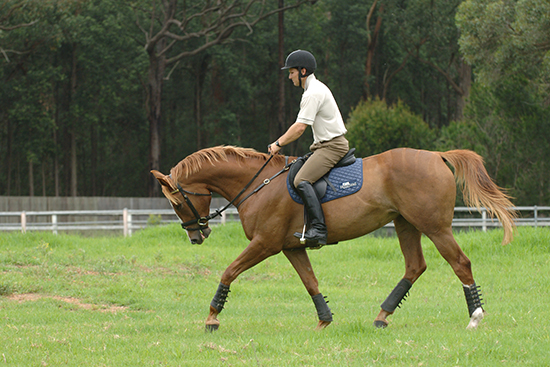
In this series, we track Meggsie’s progression as she graduates from at-home schooling to her very first competition. We watched Meggsie’s second cross country training session and sat Shane down afterwards to discuss the chestnut mare’s progress.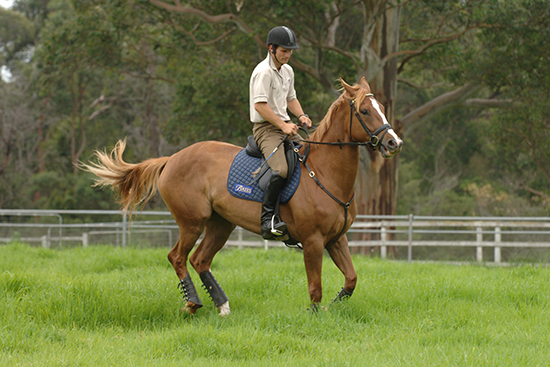
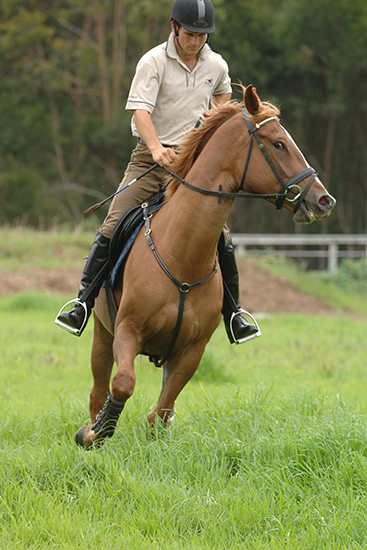
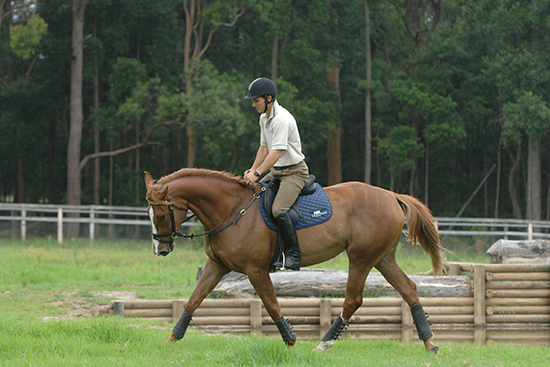 But before she got to jump, a little flat work was in order. At this stage, Shane is more interested in frame than how flash they can move…
But before she got to jump, a little flat work was in order. At this stage, Shane is more interested in frame than how flash they can move…
“For my event horses, I want to be able to control them. The first thing I do is ask them to go in a frame. Once they’re broken in and do all those normal things, the first dressagey thing I would do is get them in a frame. That is, not necessarily in an advanced frame but the frame that I want, whatever that frame be, whether it’s quite round or a little more open. And they have to stay in that frame and they have to be adjustable and moveable, forward, backward, sideways so that I can go to a competition and trot around an arena and be in a frame.”
“If you can’t control a horse in a dressage arena, then going into a jump, you’re not going to have much control either.”
“Then, maybe three, six months, down the track, when this horse is in a nice frame and I can put it wherever I want. When it then starts to go forward and starts to engage properly, as in being very correct, stepping straight through and slowly building up its movement, then we can start to worry about the quality of the movement rather than first getting big movement but not being able to control it.”
Shane’s jumping training allows the young horses to learn from their own mistakes while at the same time equipping them with the right tools to get themselves out of trouble later on. Meggsie does have a little whoopsie and learns the lesson. Shane’s jumping philosophy is straightforward. It’s as easy as falling off a…
“If there are five horses cantering in the paddock and there is a log in front of them, if one gets pushed in front of the log, they jump it. They naturally know how to jump. So I presume, when I’m going cross-country schooling, that if I canter up to a log, the horse is going to jump it. All I’ve got to do is keep it straight and if the horse can’t get around it, it’ll jump. Once it gets the idea that it has to jump, then I encourage that and they learn to jump. I want to teach my horses the principle that if I make a mistake, they will help me out, they can get out of any situation. I try not to make mistakes, but it’s pretty hard when you’re going cross-country to never make mistakes. Up until probably Pre-Novice I aim to get to a nice distance but if I don’t and the horse gets there awfully, then I just let it happen.”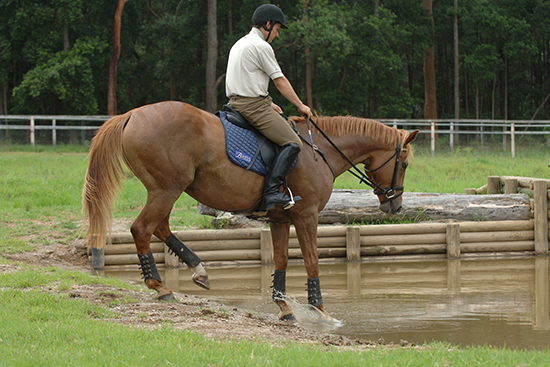

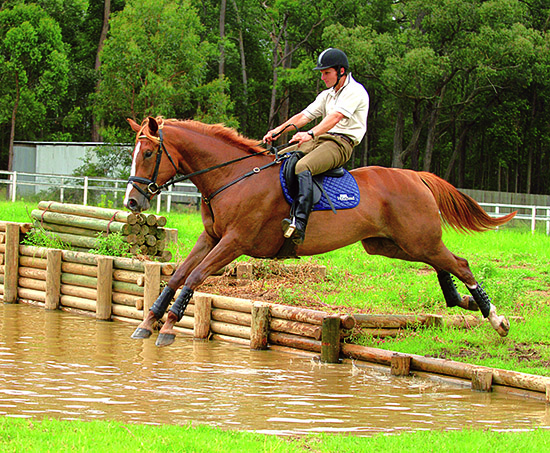
So that’s what happened at the bank today?
“She jumped into the water too big, instead of just cantering in and putting in two short, she jumped in big and didn’t listen and didn’t wait and one leg went up the bank, one leg down. It was really uncomfortable for her and she stumbled her way through. I didn’t want her to do that, she didn’t listen to me, oh well, she learnt the hard way.”
“The next time I came around, she backed off when I asked her wait and got a good distance coming off the bank. I ride my horses trying to get a good distance but if they don’t listen because they are being ignorant, then they make it difficult for themselves. Eventually, when they listen to me, if something does go wrong, they can get out of that situation without relying on me. Hopefully 99 times out of 100, I’ll get it to a good distance once the horse is trained and adjustable but if I don’t on that odd occasion, then the horse will be able to get its own way out.”
Once you’ve got them so that you can ride them, how soon do you want to start popping them over fences? Do you start in the showjumping arena or do you start them with logs out in the paddock?
“At the beginning if I go into the paddocks, it’s for fun, it’s not as a training exercise for jumping. I would probably start my horses off the same way as a showjumper would in an arena over poles. I start by popping them over a cross rail, but they have to jump that cross. If they run out, they get into lots of trouble, if they stop they get into lots of trouble. I teach them normal exercises, trot poles, grids. I probably don’t do as much grid work because I don’t know so many exercises. I do a lot of work over cross rails, four or five strides to a little oxer. That’s the basis of my grid work I guess. Generally I get them to trot in over a cross rail, they must be straight, canter down, and jump a little oxer. I try and make them canter down in a nice shape if I can, but the main thing is they do have to canter down and jump.”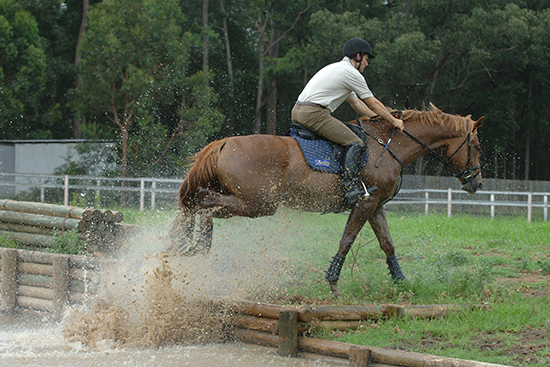
“With my eventers, until they’re jumping comfortably in a showjump arena up to a metre, then I haven’t pointed them to the cross country fence or a log because when they make a mistake over a showjump, it doesn’t hurt as much. Generally, a horse will canter to a log and they’ll jump it fairly well but then you take that same horse back and jump a showjump fence, they don’t necessarily know what they’re doing, so I definitely start with the showjumps.”
“Horses jump cross country fences naturally, it’s not foreign to them. If they can jump a showjump fence and they can jump well, you can canter them up to a fence that is the equivalent height cross country and they know that they’re not allowed to get around it, they pretty soon work out how to jump it and how to jump it well.”
It’s a big difference for you now that you’re starting to ride a few horses that haven’t gone racing and haven’t been stuffed up by those awful pre-trainers of racehorses.
“There are some good pre-trainers (For those not in on the joke, Shane has a ginormous racehorse pre-training operation, with something like a hundred top horses in work at any time…). I don’t think so, I think horses are horses, I treat them all the same…”
But is it a different set of problems?
“Yes and no. A horse that’s been through a racing preparation, if it hasn’t been wrecked, then it is really, really beneficial because from the age of six months they’ve been handled, they’ve been put through sales preparation so they’ve got used to everything from a young age. They then get broken in fairly early. If they go to a good trainer, they tend to do short spells. They’re coming in and out of work, they see the racetrack, they see the people and events. If that horse isn’t that good at running and also isn’t run off its feet then it’s a great start – you end up with a three or four year old horse that’s had all this experience. If you compare that to a purpose bred horse such as a Warmblood…”
Like the one you’ve been working today?
“Yeah, she’s done nothing. She’s a four year old, she’s never been out in public so everything to her is ‘oh, my God, this is the scariest thing in the world!’ Whereas a racehorse, if they’re a quiet horse and I think that’s probably the thing: if you get the right racehorse then they’re much, much more advanced before you even start to touch them.”
“You have problems where some of them are handled poorly and they have issues and they don’t steer or stop and do all sorts of silly things. But if you get a nice one, then a Thoroughbred is much more advanced than a purpose bred horse at the same age.”
“But then if you have purpose-bred horse, and you do everything with it yourself, then the horse should have no reason to get upset if you’ve trained it well.”
This mare seems to have a pretty natural jump in her but then she’s by a horse that jumped World Cup so do you feel that when you’re in the saddle, hey, this is significantly different to something that’s bred to win the Blue Diamond?
“I think careful horses, horses that can jump, it wouldn’t matter what you did to them, they’re always going to be good jumpers to a degree, a pretty big degree. Horses that are not going to be careful are never going to be good jumpers. They might get around some Advanced tracks like some of our good horses in the past, but they won’t get to the top anymore. The sport is changing, it’s moving on, if they’re not good, naturally careful jumpers, then they’re not going to be competitive.”
“The first time I jumped her, Meggsie probably jumped two or three cross rails. The next time I jumped her, I was probably jumping her at a metre, well, maybe not quite a metre but she knew how to jump. She knew that if she hit the rail, it would hurt and she didn’t want to do that.”
“She always jumped in a fairly good shape. When she first started, she was a little brave and probably because I wouldn’t let her stop, she jumped over the back of the fence. So then we did a little bit of work placing poles behind the fence to make her jump rounder and that worked well for her. So she’s naturally always had a good jump which is great.”
“If you then take a Thoroughbred horse that naturally has a good jump, they’re similar. But the thing is that when you’ve got a purpose-bred horse for jumping, there’s more of them that have that natural jump. Whereas the Thoroughbred, because they’re bred to run, unless they’ve got the good jumping lines or they’re a natural jumper, there’s going to be much, much fewer of them, you’ve just got to make sure you get the right one.”
So what do you do with Meggsie now?
“I guess her plan would be to do probably a couple of months, she’s been in about a month now. She’d been broken in for maybe six weeks, just trotting around, getting her used to things. Then she had a few months off. She’s probably not that far off doing an event. I think she might be going to a prelim event in a couple of weeks. Then I’ll probably take her pre-novice for the next start if everything goes well. And then I’ll give her a pre-novice start or two and then she’ll probably have a holiday. Because she’s quite young, I quite like to do a bit with my young horses and then give them a month or two off and then bring them in and do the same sort of program. Give them a look around; let them figure it all out. Keep it all pretty low key. When I take her out, as long as she does everything correctly in the dressage I don’t care if she wins or comes twentieth as long as she does everything that I want her then I’ll be happy and if she does that, she’ll probably be towards the front anyway because we won’t be wasting too many marks.”
“I like the theory that the Thoroughbred trainers use. Give them short spells of work, give them a holiday so then they’re not doing any damage and then they come in fresh all the time, they’re happy, like a horse I just sold, Gandalf the Grey, a six year old Advanced horse. He’d actually had two advanced starts before he was even six. I kept holding him back because he was so relaxed about it, he did everything so easily. He’s an Advanced horse at six and has done all of this because he started quite early but I only ever did a month or two with him and kept turning him out and because he had a very good attitude, I kept having to try not take him up the grades too quickly, he probably could have been three star as a four year old. As a philosophy that’s a good way to work with young horses.”

Was that Al Landra’s first session at the water?
“I think I took her in the other day. It’s actually her second time. She was no less confident jumping the big log in than she was when she walked in the first time. That’s what I’m getting at with my theory in jumping logs. She walked into the water, she knew it wasn’t deep, she trotted out up the bank, she knew that was okay. When she jumped back in, she jumped in quite boldly and quite big but each time it was the same. Each time she was no more stressed than the time before. It was just a little bigger.”
“When I jumped off the largest of the drops, she was a little hesitant but jumped in fine. She just went, ‘Ohh, that’s a big drop’ and then jumped in. The next time I cantered round she was exactly the same. The first time I jumped the log in she went, ‘Ohh, there’s a bit of a drop and a bit of a log’ and then jumped in fine and each time she was happy with it because she knows exactly what was happening.”
“I think jumping into water is something horses naturally do quite well. The one thing that is really important – I never take my horses into any water jump that’s not got a good surface on the bottom, or is too deep, and that was bordering on too deep. Horses, if they know how to jump and are confident, they are quite smart animals. Different jumps don’t worry them, really. If you teach them how to jump up and down a bank, over a ditch, into water and jump a narrow fence, generally that’s most of your fences.”
“The only other thing is that they’ve got to be confident, if they’re confident, they’ll jump into space or fences where they can’t see landings. Really in cross-country, the difference between one course and the next course is someone’s imagination, not necessarily the jumps. The jumps are the same, they just look different. Pretty much there’s a vertical, there’s a log, there’s a ditch, there’s a bank and combinations of that.”
“When a horse is confident and I go schooling and quite often I’ll jump novice-intermediate fences on horses that have never been cross country schooling before – so long as they can build up to it. If they jump a little ditch and they jump it confidently and the next one up is a bit bigger and they jump it confidently. The next one up happens to be a novice fence and they jump it confidently, they’re not being hurt by it and they’re not worried about it. I’m quite happy to do that. I will go as far as I think a horse is happy to go.”
“You can go further schooling if you’ve got several steps to get there. To go out and jump a prelim drop into water and then an intermediate drop into water with a log, the horse is going to be really scared because the second fence is big and then it’s going to jump awkwardly and have an awkward experience but if you jump a little log with a little drop and then a slightly bigger log with a bigger drop, it’s the same thing, just bigger and it didn’t hurt them the time before so when they’re confident you go to the next level.”
“With all my schooling, I try to only school fences where I have a bigger one or a smaller one handy, so that you can build confidence and keep it. They know they’re not allowed to stop but if they have an awkward jump, sometimes it helps to pop them over a smaller one or an easier one that they’re comfortable with, then they’ll go back to the bigger one and jump it better and then you shouldn’t have problems with horses cross country.”
Next issue, Shane takes Meggsie out showjumping at SIEC…
This article first appeared in the June 2006 edition of The Horse Magazine



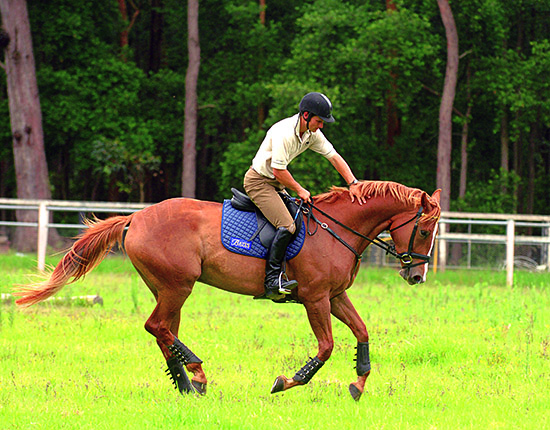
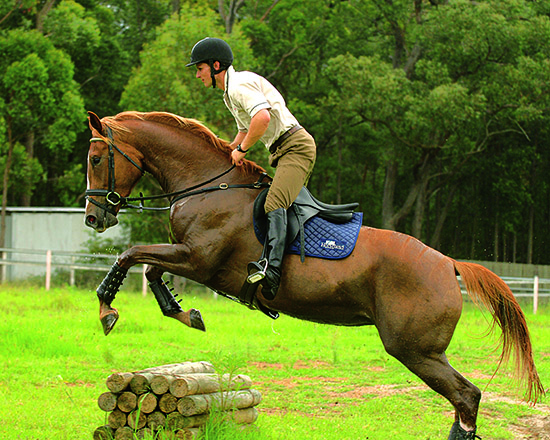
Do not like to come last!@@@
Highly competitive but consider myself myself a hack rider with an ex racehorse with plenty of spirit!!!!